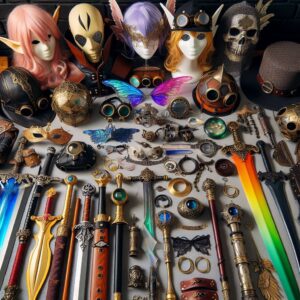Article-at-a-Glance
-
3D printing offers a cost-effective solution for creating detailed cosplay helmets.
-
Customization is a major advantage of 3D printing, allowing for unique designs.
-
Material costs for 3D printing can vary, but are often lower than traditional methods.
-
The cosplay community benefits from the sharing of 3D models and printing techniques.
-
Beginners can start 3D printing cosplay helmets with a few essential tools and guidance.
What is the typical cost of a 3D printed cosplay helmet?
Keep in mind that the most valuable saving is your time. Then, When you start crunching the numbers, you’ll find that the cost of a 3D-printed cosplay helmet is also accessible. Depending on the complexity and size, material costs can range from $50 to $200. Keep in mind that this is a ballpark figure and doesn’t include the one-time purchase of a 3D printer or the cost of finishing supplies like paint and sealant. But once you’ve got your setup ready, you’re all set to print helmet after helmet, making the most of your investment.
How does 3D printing allow for customization of cosplay helmets?
Customization is where 3D printing truly shines. You’re not limited to what’s available in stores or what you can physically craft by hand. If you can dream it, you can design it—or find someone who can design it for you. Adjusting the scale, adding intricate patterns, or incorporating moving parts are all within reach. With 3D printing, your helmet isn’t just a costume piece; it’s a personal statement.
How has 3D printing impacted the cosplay community?
3D printing has been nothing short of transformative for the cosplay community. It’s democratized the creation process, making it possible for anyone with a printer and a bit of know-how to create professional-looking costume pieces. The sharing of designs and techniques online has also fostered a spirit of collaboration and learning. It’s not just about showing off your latest creation; it’s about

growing together as creators and pushing the boundaries of what’s possible in cosplay.
Breaking Down the 3D Printed Helmet Revolution
Remember the days when crafting a cosplay helmet meant hours of sculpting, sanding, and painting? Those days are fading into the rearview mirror, thanks to the revolutionary world of 3D printing. This isn’t just about cutting corners; it’s about opening a realm of possibilities that allows you to bring your most intricate helmet designs to life with precision and ease. And the best part? It’s not just for the pros. With some guidance, anyone can join the revolution.
What Makes 3D Printing Game-Changing for Cosplay Helmets?
So, what’s the big deal with 3D printing? Imagine crafting a helmet that looks like it leaped straight out of a video game or comic book. 3D printing makes that possible. It’s all about the details – the textures, the contours, the fit. With 3D printing, you can achieve details that are tough to replicate with traditional crafting methods. Most importantly, you can tweak and adjust your design with a few clicks, without the need to start from scratch each time.

Besides that, the community aspect is huge. Online platforms are buzzing with creators sharing their 3D models and painting techniques, making it easier to learn and improve. This isn’t just crafting; it’s a way to connect with fellow enthusiasts worldwide.
Cost Analysis of 3D Printed Cosplay Helmets
Let’s talk numbers. The cost of creating a 3D printed cosplay helmet can vary, but generally, it’s a wallet-friendly option, especially when you consider the level of detail you’re getting. It usually costs between $50 to $200 for materials, depending on the size and complexity of the helmet. Compare that to traditional materials and the hours of labor involved, and you’ll see why 3D printing is taking the cosplay world by storm.
Comparing Expenses: Traditional Craftsmanship vs. 3D Printing
|
Expense |
Traditional Craftsmanship |
3D Printing |
|---|---|---|
|
Materials |
$100-$300 |
$50-$200 |
|
Labor |
Hours at varying rates |
Hours at a fixed cost |
|
Tools |
$50-$150 |
$20-$100 |
|
Finishing |
$20-$100 |
$10-$50 |
Breaking Down the Price: Material, Equipment, and Time Investment
The real beauty of 3D printing is in its efficiency. You’re not just saving money; you’re saving time. And in the world of cosplay, time is just as precious as your budget. The initial investment in a 3D printer might seem steep, but it pays off quickly. You can find a decent entry-level printer for around $200-$500, and it’s a one-time cost that paves the way for countless projects. The filament – that’s the material you’ll print with – is where the ongoing costs come in, but with smart design choices, you can make the most of every spool.
Now, let’s not forget the finishing touches. Sanding, painting, and sealing your helmet will require some additional supplies, but again, these costs are often lower than what you’d spend on traditional materials. Plus, the satisfaction of peeling off that painter’s tape to reveal a crisp, clean line is priceless.

Fostering Creativity and Community Through 3D Printing
Building Bonds: Collaborative Projects and Sharing Platforms
3D printing isn’t just about creating something cool to wear; it’s about the people you meet along the way. There’s a whole community out there, from seasoned pros to eager beginners, all sharing the same passion for bringing fantastical designs to life. Collaborative projects are common, with people combining their skills to create something truly special. And the sharing doesn’t stop at the finished product – it’s about the process, the triumphs, and the inevitable hiccups along the way.
Cosplay Success Stories: Community Highlights
Take Alex, for example. She was new to cosplay and decided to dive into 3D printing. With help from online forums and a bit of trial and error, she crafted a helmet that became the talk of her local convention. It wasn’t just the helmet that was a hit – it was her story of perseverance and community support that resonated with fellow cosplayers.
“I couldn’t have done it without the tips and encouragement from the online community. It’s not just about the printing; it’s the people that make this journey worthwhile.” – Alex, Cosplay Enthusiast
Implementing 3D Printing in Your Cosplay Projects
Ready to start your own 3D printing adventure? It might seem daunting at first, but with the right approach, you’ll be crafting incredible helmets in no time. The key is to start with a solid plan and to take it step by step. Remember, every expert was once a beginner – and every epic helmet started as just an idea.
Step-by-Step Guide to Creating Your First 3D Printed Helmet
First things first: you need a design. Whether you create your own or download one from a talented designer, make sure it’s a helmet you’re excited about. That excitement will carry you through the learning curve. Next, get familiar with your 3D printer. Understand its quirks and capabilities because knowing your tool is half the battle.
-
Choose or create a 3D model of your desired helmet.
-
Use slicing software to prepare your model for printing.
-
Print your helmet and monitor the process for any issues.
-
Clean up the print, removing any supports and sanding as needed.
-
Paint and finish your helmet, bringing your vision to life.
And there you have it – a cosplay helmet that’s uniquely yours, ready for its convention debut. Remember, patience is key. Your first helmet might not be perfect, but each print is a learning experience, a stepping stone to your next masterpiece.
Tools of the Trade: Must-Have Equipment for a Seamless Experience
Before you dive in, make sure you’re equipped for success. You’ll need a 3D printer, of course, but also slicing software, which is used to translate your 3D model into instructions for the printer. Stock up on filament, the material your helmet will be made from, and have tools on hand for post-processing, like sandpaper and paint. These are your essentials:
-
A reliable 3D printer suitable for the size of your projects.
-
Slicing software to prepare your 3D models for printing.
-
Quality filament in the colors and materials you need.
-
Basic tools for cleaning and finishing, like sandpaper and craft knives.
-
Paints and sealants to give your helmet a professional look.
With these tools at your side, you’ll be well on your way to creating helmets that not only look amazing but also tell a story – your story.
Frequently Asked Questions (FAQ)
What is the typical cost of a 3D printed cosplay helmet?
The cost can range widely based on size, design complexity, and the type of filament used. On average, you’re looking at about $50 to $200 in materials. This doesn’t include the initial investment in a 3D printer and tools, but those are costs that will spread out over many projects, making them more affordable in the long run.
What materials are most commonly used for 3D printed cosplay helmets?
The most popular material for 3D printing cosplay helmets is PLA (Polylactic Acid), which is a biodegradable thermoplastic derived from renewable resources. It’s user-friendly, comes in a variety of colors, and is relatively inexpensive. For those looking for more durability or unique finishes, materials like ABS (Acrylonitrile Butadiene Styrene), PETG (Polyethylene Terephthalate Glycol), and even flexible filaments are also options. Each material has its own properties, so choose what best fits the needs of your project.
What are some tips for beginners starting with 3D printed cosplay projects?
If you’re just stepping into the world of 3D printed cosplay, here are a few tips to set you on the path to success:
-
Start with a simple project to familiarize yourself with the printing process.
-
Invest in a reliable 3D printer that fits your budget and space.
-
Join online communities to learn from others and share your progress; join our newsletter & Facebook group.
-
Don’t be afraid of failure; every misprint is a learning opportunity.
-
Practice finishing techniques like sanding and painting to give your helmet a polished look.
Remember, the journey is as rewarding as the destination. Enjoy every step, and don’t hesitate to reach out to the community for advice and support.


